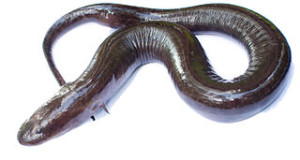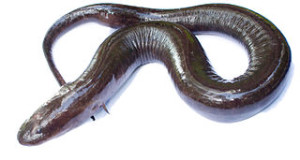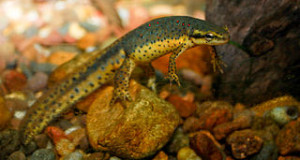One of the world’s rarest amphibians is being bred by dedicated hobbyists and is now available in the US pet trade. Anderson’s salamander, Ambystoma andersoni, which was only formally described in 1984, is limited in range to a single high altitude (6,000+ feet above sea level) lake and stream in south-central Mexico (Laguna de Zacupa, Michoacan, Mexico). The IUCN lists it as “Critically Endangered”.
Rare Aquatic Salamanders of Mexico’s Highlands
 Anderson’s salamander is part of a complex of similar aquatic, neotenic salamanders which includes the Mexican axolotl (A. mexicanum). Neotenic species retain larval characteristics such as external gills and an aquatic lifestyle upon maturity.
Anderson’s salamander is part of a complex of similar aquatic, neotenic salamanders which includes the Mexican axolotl (A. mexicanum). Neotenic species retain larval characteristics such as external gills and an aquatic lifestyle upon maturity.
A dozen or more species of these unique, poorly-studied amphibians inhabit mountain lakes in Mexico. Most are found only in a single lake or, in the case of the axolotl, may exist only in canals and other habitat remnants. Some, including the Dumeril’s salamander (A. dumrelii), seem to have adapted to waters that are somewhat saline in nature.
Hope for the Species’ Survival
The sole population of Anderson’s salamanders is threatened by pollution, habitat loss and collection for the (human) food trade. Its relative, the Mexican axolotl, was saved from extinction by captive breeding efforts, and is now in the unique position of being one of the most common captive and rarest wild salamanders.
 Originally surfacing in Europe, captive-bred Anderson’s salamanders are now available in the USA as well. This represents a unique opportunity for serious hobbyists to help learn about and conserve an endangered species. As a bonus, Anderson’s salamander is large, beautifully patterned and relatively hardy as well.
Originally surfacing in Europe, captive-bred Anderson’s salamanders are now available in the USA as well. This represents a unique opportunity for serious hobbyists to help learn about and conserve an endangered species. As a bonus, Anderson’s salamander is large, beautifully patterned and relatively hardy as well.
Keeping Anderson’s Salamander
The captive husbandry of Anderson’s salamander is similar to that of the Mexican axolotl (please see article referenced below)…please write in if you are interested in becoming involved what may become a most worthwhile amphibian breeding effort. At this point, noted salamander specialist Michael Shrom is likely the only person breeding Anderson’s salamanders in the USA. You can contact Michael at shrommj at ptd.net.
Further Reading
 You can read more about the natural history of Anderson’s salamander and its relatives at http://www.mexico-herps.com/caudata/ambystoma/ambystoma-andersoni.
You can read more about the natural history of Anderson’s salamander and its relatives at http://www.mexico-herps.com/caudata/ambystoma/ambystoma-andersoni.
For information on the Mexican axolotl, please see my article The Natural History and Care of the Mexican Axolotl http://blogs.thatpetplace.com/thatreptileblog/2008/12/19/the-natural-history-and-captive-care-of-the-mexican-axolotl-ambystoma-mexicanum-natural-history-part-1/.
Photos courtesy of Michael Shrom.
 That Reptile Blog – Reptile, Amphibian and Exotic Pet Care and Information
That Reptile Blog – Reptile, Amphibian and Exotic Pet Care and Information




I live in Blackhawk, CO about 9000 ft above sea level. I was walking through the subdivision and there is a very small pond, about 15ft deep, about as big around as half of a basketball court. The water is very cold because its all just run off. Anyways I couldn’t believe my eyes there was a critter that looked an awful lot like these guys. He was the only one in the pond. I was stunned, how do these things live in such harsh conditions!
Hello John, Frank Indiviglio here.
Thanks for your interest in our blog and the most interesting and unique observation. If the creature you saw was 4 or more inches in length, then it was most likely the larvae of a Tiger Salamander. Usually they transform into a land-dwelling adult; however, in very cold or very dry habitats, they may remain in the larval stage permanently, maturing and reproducing without ever leaving the water (a process known as neoteny or paedomorphosis). These “adult larvae” may reach 12 inches in length. Other salamander larvae native to your area resemble the Anderson’s Salamander in form, but transform into adults at smaller sizes and are hard to spot.
Very interesting observation, thanks, please let me know the size if you have time.
Many salamanders are very well adapted to cold conditions, and fail to thrive in captivity at normal room temperatures. I’ve observed European Fire Salamanders foraging at 36 F! Their bodies produce a glycerol-based “antifreeze” in winter, to prevent cell damage. This is being studied with a view towards freezing human organs destined for transplantation.
Good luck, enjoy and please keep me posted.
Best regards, Frank Indiviglio.
my dames dyllan baxter and i just buaght a male and female just like these but mine are darker and we hope to breed them but i realy dont know mutch about them and could use some information on this species
Hello Dyllan, Frank Indiviglio here.
Thanks for your interest in our blog. Anderson’s Salamanders can be cared for as described in this article on Mexican Axolotls. You may wish to double check what species you have – Anderson’s are not common in the trade, and usually sell for $100 + each; they are very similar in appearance to the more common Mexican Axolotl.
Good luck and please keep me posted.
Best regards, Frank Indiviglio.
very good…………
i have crocodilesalamander
Hello, Frank Indiviglio here.
Thanks for your interest in our blog and the kind words; I look forward to your observations and comments.
Good luck and please keep me posted.
Best regards, Frank Indiviglio.
hello im looking to buy this breed of salamander the Andersoni. a few people have them but only have one. so i would like to breed them and have some for my self. contact me with photos and info and fee .. thanks so much
Hello Charlie,
I’ll email Michael Shrom’s contact info. He is the first to have bred them in the USA, not sure about status now. Include “Frank Indiviglio” in subject line when you contact him, Best, Frank
do you know of anyone else now who is breeding them? very interested… please email me if so
Hi Ashley,
Michael Shrom, a grear resource for captive bred salamanders, has bred them in the past. Try him at shrommj@ptd.net, let him know I referred you. Good luck, Frank
Does anyone know if he still breeds them ? I am an experienced amphibian keeper and have kept plenty of Newts, Salamanders & my absolute favorites Axolotls❤️. I would love to purchase a pair in hopes they can breed and not go extinct 🙁 .. Can anyone direct me to someone who does sell them . I know it seems near impossible..
Hello Jennifer,
I do not believe he (Michael Shrom) is breeding them any longer. You should be able to connect with him to check via kingsnake.com; he has advertised there in the past. Best, frank